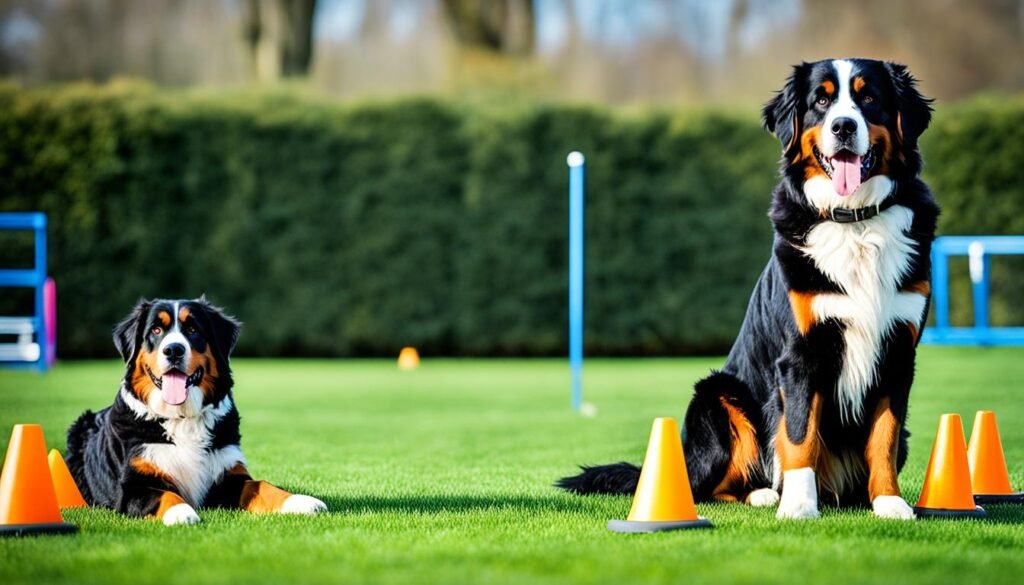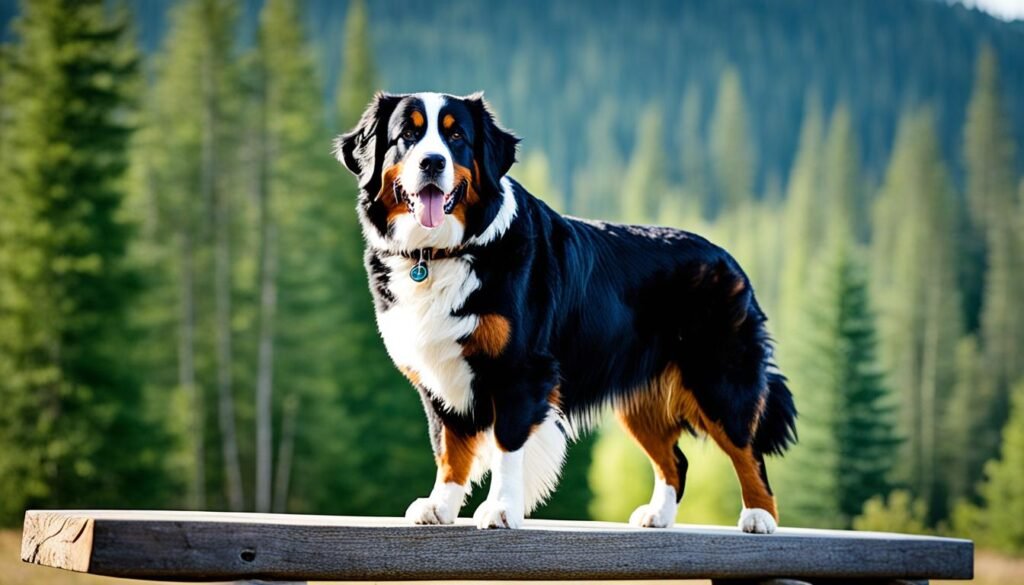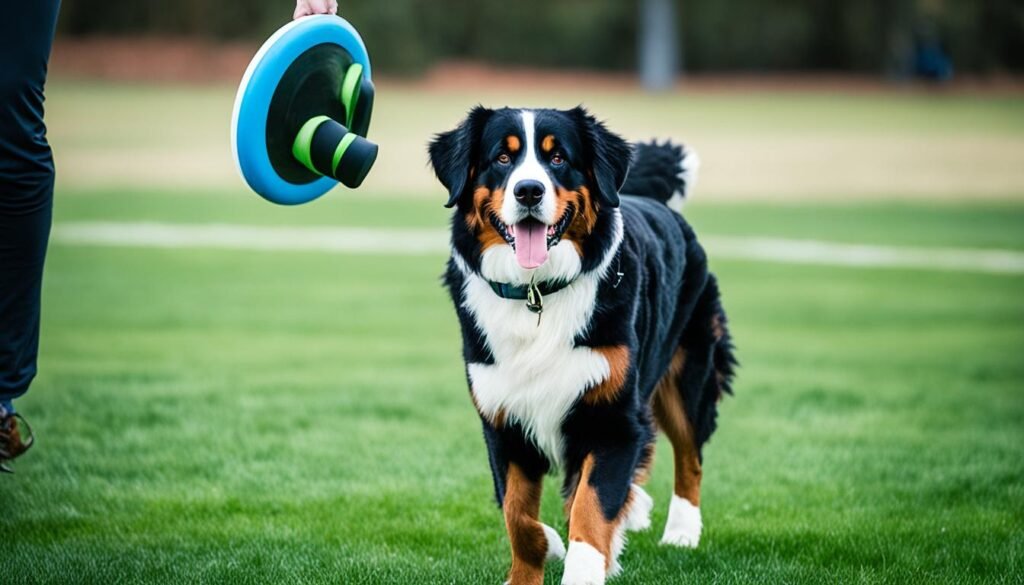As I gaze out at my beloved Bernese Mountain Dog, Bella, I’m reminded of the immense joy and challenges that come with training these gentle giants. Bernese Mountain Dogs are known for their loyal, affectionate nature, and their intelligence makes them eager to please their owners. However, their sheer size and sensitivity require a specialized approach to ensure they grow into well-behaved companions1.
Whether you’re a first-time Berner owner or a seasoned dog parent, navigating the training journey can be both rewarding and daunting. In this comprehensive guide, I’ll share the essential tips and tricks I’ve learned over the years to help you train your Bernese Mountain Dog effectively, from mastering basic commands to building a strong bond through positive reinforcement.
Key Takeaways
- Bernese Mountain Dogs can weigh between 70 and 115 pounds when fully grown1
- Proper socialization and training should start as early as 8 weeks old1
- Positive reinforcement is the most effective training method for Berners2
- Short, frequent training sessions of 10-15 minutes are recommended2
- Consistency and patience are key when training a Bernese Mountain Dog2
Preparing to Train Your Bernese Mountain Dog
As a large and gentle breed, the Bernese Mountain Dog requires a thoughtful approach to training. These majestic pups can weigh up to 100 pounds3, so understanding their breed characteristics is crucial before embarking on their training journey.
Understanding the Breed’s Characteristics
Bernese Mountain Dogs are known for their calm and affectionate temperament, as well as their intelligence. However, they can also be sensitive to harsh corrections and do not fare well when left alone for extended periods4. Taking the time to comprehend these unique traits will help you tailor your training methods to your Berner’s needs.
Getting Ready for Training
When preparing to train your Bernese Mountain Dog, it’s best to start as early as 3 months old3. At this age, they have the attention span to begin learning basic commands like sit, stay, and come. To get started, you’ll need a collar, leash, and their favorite treats3. Positive reinforcement through the use of treats and a marker (such as the verbal cue “YES”) can be an effective training approach for these sensitive pups3.
As you embark on your Bernese Mountain Dog’s training journey, remember to be patient and consistent3. Daily practice is the key to reinforcing the commands you teach, and gradually reducing the treats as your dog masters each skill3. With the right preparation and understanding of your pup’s unique characteristics, you can set your Berner up for training success.

Training a Bernese Mountain Dog: Essential Tips
Consistency and Preparation
Consistency is key when training a Bernese Mountain Dog. All family members must be on the same page with the commands used and training methods5. Preparation is also vital – you need to set your Berner up for success by training in a quiet environment with minimal distractions at first, then gradually increasing the difficulty5.
Positive Reinforcement
Positive reinforcement is the best training approach for sensitive Bernese Mountain Dogs5. The idea is to reward your dog with treats, praise, and playtime when they exhibit the behaviors you want to see, rather than punishing them5. Berners respond much better to this method than harsh corrections, which can lead to anxiety and fear6.
Training a Bernese Mountain Dog requires patience and consistency5. They are intelligent dogs6, and starting training early is crucial, as they grow rapidly6. Positive reinforcement techniques, such as rewarding good behavior with treats and praise, are highly effective for this breed56.
Bernese Mountain Dogs are prone to joint issues, so it’s essential to monitor their health during training and consult a veterinarian if any problems arise6. With the right approach, you can train your Berner to be a well-behaved and loving companion5.

| Characteristic | Description |
|---|---|
| Height | Male: 25-27.5 inches, Female: 23-26 inches7 |
| Weight | Male: 80-115 pounds, Female: 70-95 pounds7 |
| Life Expectancy | 7-10 years7 |
| Coat | Double coat, medium length, requires regular grooming7 |
| Shedding | Moderate shedding, regular brushing required7 |
| Drooling | Moderate droolers, especially after drinking water or anticipating treats7 |
| Temperament | Affectionate, loyal, gentle, and good with children7 |
| Sociability | Sociable with other dogs, can get along well7 |
| Trainability | Intelligent, respond well to consistent training7 |
| Energy Level | Active, require regular exercise7 |
| Barking | Not excessive, but will bark to alert owners7 |
| Health Concerns | Hip and elbow dysplasia, cancer, bloat, progressive retinal atrophy, and heart diseases7 |
In summary, training a Bernese Mountain Dog requires a consistent, positive approach, with early socialization and a focus on their unique needs576. By following these essential tips, you can help your Berner become a well-adjusted and loving family member.
Conclusion
Training your Bernese Mountain Dog is a wonderful way to bond and get to know each other. While it requires patience and consistency, following these tips will set you up for success8. By using positive reinforcement, keeping training sessions short and fun, and gradually increasing the difficulty, you can raise a well-mannered, confident Berner that loves to learn9.
The optimal starting age for training Bernese Mountain Dog puppies is typically recommended to be around 7-8 weeks8, and the socialization period is crucial between weeks 3 to 148. Neglecting early training can lead to behavioral issues such as size and strength challenges, separation anxiety, excessive barking, and overprotectiveness8.
Breed-specific online training platforms are gaining popularity, providing tailored modules for Bernese Mountain Dogs to address their unique behaviors and tendencies8. These platforms offer flexibility for busy owners, allowing learning at one’s pace, access to resources like videos, articles, and interactive sessions, and revisiting lessons for reinforcement8. With consistent positive reinforcement and dedication, you can create a strong bond with your furry companion and ensure they reach their full potential.




